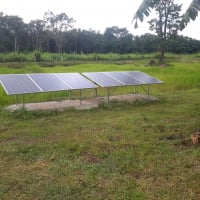Worth converting from 24 to 48 volt system?
Options
openplanet
Registered Users Posts: 34 ✭✭
I currently have:
*24 volt, 405ah battery bank in the form of 4, 6 volt batteries in series
*2 series strings of 3, 295 watt panels (about 110 vdc comes in to the controller)
*Classic 200
*lights, ceiling fan, and 'fridge are 24vdc
*24v, 2kw inverter
I'm planning to add two more strings of 3 panels each and another Classic 200. I could double my battery capacity with either
*two parallel 24v strings of 4, 6 volt batteries, or
*a single series string of 8 batteries for 48 volts.
In either case they'll all be new batteries. I understand that (1) it's better to avoid parallel battery strings if possible, and (2) the controller is more efficient as the input voltage is closer to the battery bank voltage. In order to convert to 48vdc I'd need to (1) sell my 24v 2kw inverter and purchase a 48 volt unit, and (2) purchase a DC-DC converter to run my 24v loads.
Here's the question: Given the above, are the benefits of going to 48vdc worth the cost?
Thanks!
*24 volt, 405ah battery bank in the form of 4, 6 volt batteries in series
*2 series strings of 3, 295 watt panels (about 110 vdc comes in to the controller)
*Classic 200
*lights, ceiling fan, and 'fridge are 24vdc
*24v, 2kw inverter
I'm planning to add two more strings of 3 panels each and another Classic 200. I could double my battery capacity with either
*two parallel 24v strings of 4, 6 volt batteries, or
*a single series string of 8 batteries for 48 volts.
In either case they'll all be new batteries. I understand that (1) it's better to avoid parallel battery strings if possible, and (2) the controller is more efficient as the input voltage is closer to the battery bank voltage. In order to convert to 48vdc I'd need to (1) sell my 24v 2kw inverter and purchase a 48 volt unit, and (2) purchase a DC-DC converter to run my 24v loads.
Here's the question: Given the above, are the benefits of going to 48vdc worth the cost?
Thanks!
Comments
-
What are your inverter loads?
Another option have 2 × 24V systems, one for DC loads and the other for inverter loads, always good to have the redundancy of a second system.1500W, 6× Schutten 250W Poly panels , Schneider MPPT 60 150 CC, Schneider SW 2524 inverter, 400Ah LFP 24V nominal battery with Battery Bodyguard BMS
Second system 1890W 3 × 300W No name brand poly, 3×330 Sunsolar Poly panels, Morningstar TS 60 PWM controller, no name 2000W inverter 400Ah LFP 24V nominal battery with Daly BMS, used for water pumping and day time air conditioning.
5Kw Yanmar clone single cylinder air cooled diesel generator for rare emergency charging and welding. -
I don't know how DC to DC converters work, or their parasite load, but You would save the cost of another charge controller.openplanet said:*lights, ceiling fan, and 'fridge are 24vdc
...two more strings of 3 panels each and another Classic 200.
...and (2) purchase a DC-DC converter to run my 24v loads.
Here's the question: Given the above, are the benefits of going to 48vdc worth the cost?
I don't have the 24 volt loads, but wish I was at 48 volts in general. I'll switch when I replace my battery.
Home system 4000 watt (Evergreen) array standing, with 2 Midnite Classic Lites, Midnite E-panel, Magnum MS4024, Prosine 1800(now backup) and Exeltech 1100(former backup...lol), 660 ah 24v Forklift battery(now 10 years old). Off grid for 20 years (if I include 8 months on a bicycle).
- Assorted other systems, pieces and to many panels in the closet to not do more projects. -
Another advantage to a single string (assuming flooded lead acid) is 1/2 as many cells to maintain.
An advantage to parallel banks is the option to live on a single string for a bit when cell(s) eventually start failing, and limp by for a while by swapping out weakening batteries from the in-use string and replacing with stronger ones from the decommisioned string. This might be more of a factor if you're really remote and replacing the bank requires lots of planning and logistics. Having a second classic also gives some redundancy.
The voltage question comes down to expected current and future loads. You could do without the second classic at 48v, and if you were starting from scratch it would probably make sense (depending on inverter loads) to go to 48v. As you're already set up for 24v though, it depends on your priorities and loads.Off-grid.
Main system ~4kw panels into 2xMNClassic150 370ah 48v bank 2xOutback 3548 inverter 120v + 240v autotransformer
Night system ~1kw panels into 1xMNClassic150 700ah 12v bank morningstar 300w inverter
Categories
- All Categories
- 228 Forum & Website
- 136 Solar Forum News and Announcements
- 1.3K Solar News, Reviews, & Product Announcements
- 199 Solar Information links & sources, event announcements
- 895 Solar Product Reviews & Opinions
- 255 Solar Skeptics, Hype, & Scams Corner
- 22.4K Solar Electric Power, Wind Power & Balance of System
- 3.5K General Solar Power Topics
- 6.7K Solar Beginners Corner
- 1K PV Installers Forum - NEC, Wiring, Installation
- 2.1K Advanced Solar Electric Technical Forum
- 5.6K Off Grid Solar & Battery Systems
- 428 Caravan, Recreational Vehicle, and Marine Power Systems
- 1.1K Grid Tie and Grid Interactive Systems
- 652 Solar Water Pumping
- 815 Wind Power Generation
- 624 Energy Use & Conservation
- 618 Discussion Forums/Café
- 311 In the Weeds--Member's Choice
- 75 Construction
- 124 New Battery Technologies
- 108 Old Battery Tech Discussions
- 3.8K Solar News - Automatic Feed
- 3.8K Solar Energy News RSS Feed

